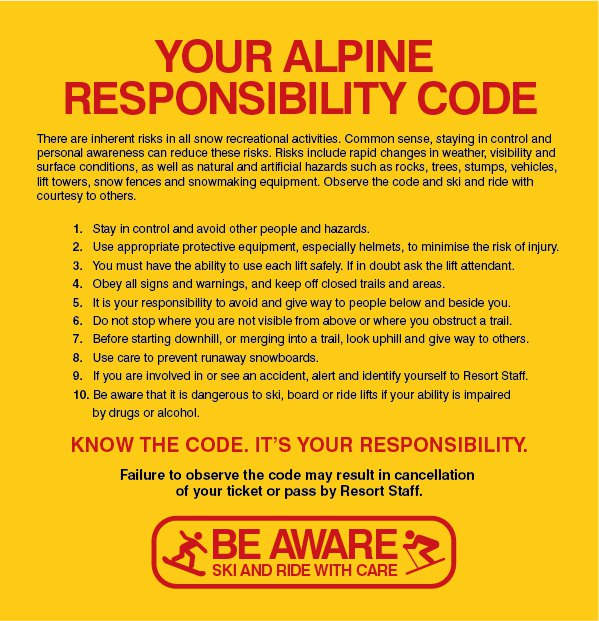Resort Information
At Perisher, the safety of our guests and staff are paramount. Please read the following information carefully, in particular, the Alpine Responsibility Code. This code is an initiative of all Australian ski and board resorts implemented for the safety of everyone.
Things to Know Gefore You Go:
Mountain Safety:
Further Information:
- www.snowsafe.org.au - useful information on safety in the alpine area.
- www.lidsonkids.org - This site is maintained by the National Ski Areas Association, USA (NSAA) and contains useful information on the use of helmets.
- Lift usage policy (below).
Lift Usage
Please reffer to the Lift Loading and Usage Policy
Food and water
Food provides energy for active adventure activities. It is necessary for maintain movement and body temperature in a cold environment. Make sure you eat a good breakfast, consider eating a little more than usual and certainly drink more water than usual. Stop when you are tired and do not consume alcohol when skiing or boarding.
Thunderstorms and lightning
In the event of lightning storms in the vicinity of Perisher, chairlifts and t-bars are closed as necessary for the safety of guests and staff. Perisher staff will direct guests and you are encouraged to return to buildings and shelters during the storm. Lift and resort facilities will be reopened once the storm has passed.
The use of drones in Perisher
A drone may also be known as a remotely piloted aircraft (RPA) or an unmanned aerial vehicle (UAV) and the recreational or commercial use of drones must be carried out safely and in accordance with the law. A drone is considered an aircraft and the rules governing the use of drones are set out in the Civil Aviation Safety Regulations 1998 (C’th), which is administered by the Civil Aviation Safety Authority (CASA).
The NSW National Parks and Wildlife Service have also published a policy regarding the use of drones within National Parks which may be accessed at this link. Perisher is concerned about the safety of our guests as well as ensuring we meet our compliance obligations and have published a policy on the use of drones within Perisher Ski Resort which is available at this link.
Perisher Assistance Animal Policy
This Policy sets out Perisher’s requirements in relation to assistance animals, balancing the rights and obligations, and the health and safety, of people with assistance animals and other resort guests and employees, as well as assistance animals. Full policy here.
|
Perisher Blue Pty. Limited Persons who behave in an unacceptable manner when using a ski lift, who place themselves and other persons in danger, who ignore instructions from lift staff, or who ignore the Alpine Responsibility Code or Perisher’s Lift Usage Policy when loading, riding and unloading a lift may have their lift access cancelled or suspended. Alpine Responsibility Code Point 3: “You must have the ability to use each lift safely. If in doubt ask for help”. Comply with the Code by adhering to the following: All Lifts:
Chair Lifts:
T Bars and J Bars:
Skier Conveyors:
**Riders participating in a Snowsports School lesson, when directed by their Instructor, may ride the carpet in ski or board boots, but only under the supervision of the Instructor. Early dismount from T-Bar or J Bar: The only time early dismount is allowed from any T bar or J Bar is when the lift has been officially shortened and the disembark point has been established at an alternate lower location. This may occur in low snow years and early or late in the season. In an emergency, early dismount may be required if staff are attending to an incident; however this must be done only when it is safe to do so. Riders are PROHIBITED from dismounting early from the following T bars AT ANY TIME:
Foot Passengers: The Perisher Express Quad Chairlift is the only chairlift at Perisher that is available for use by foot passengers. To be able to ride as a foot passenger each person must be able to walk unassisted to and from the chairlift, and load and unload the chairlift unassisted. Foot passengers are limited to staff working for the licensee at the Mid Station Restaurant. Other chairlifts maybe used for foot passengers in exceptional circumstances. (eg: downloading a guest with faulty equipment). Other Devices: Snow bikes, scooters, snow skates, sled dogs (ski boots with ski base on the sole of the boot), speed riding (paragliding with skis) and kite boarding are not permitted on lifts. KNOW THE POLICY. IT IS YOUR RESPONSIBILITY. |
|
IMPORTANT NOTICE - WARNINGS, SUSPENSION AND CANCELLATION Violation of the ALPINE RESPONSIBILITY CODE will result in the following penalties All Lift Tickets including Season Pass Holders All violations will be recorded on the Mountain Safety Database with the person's name and lift ticket details
KNOW AND ABIDE BY THE CODE IT'S YOUR RESPONSIBILITY ENJOY SNOWSPORTS BE CAREFUL Perisher Blue Pty Limited ACN 061 232 488 |



